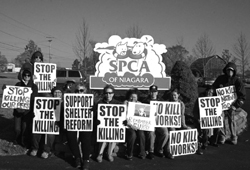Niagara County SPCA on track to no-kill policy
By Tony Farina
 |
 |
 |
| Protestors made their case and their voices have been heard! |
The Niagara County SPCA’s kill numbers and the lack of interest in caring for animals, as documented in a scathing report, put the shelter and its staff in the spotlight at the start of the year and led to the firing of its $70,000-a-year director, John Faso, in late January. (The alleged animal abuse was first reported by Rick Pfeiffer of the Niagara Gazette.)
The critical report by Erie County SPCA Director Barbara Carr, released Jan. 27, said investigators found that in the last three months of 2011, under Faso’s watch, 473 cats and 100 dogs had been euthanized at the Niagara County SPCA. And according to Peter Reese, a lawyer and animal rights activist, during that period “they were routinely killing cats with a heart stick,” a crime under state law, and the animals had not been anesthetized.
The shocking revelations unleashed a torrent of public anger and led to sweeping leadership changes which, according to Reese, a member of the Niagara County SPCA, have dramatically improved conditions and moved the shelter in a no-kill direction which means that at least 90 percent of the animals have to leave alive. Niagara County is edging closer to that mark under its new leadership with a save rate now pegged at about 86 percent.
But change doesn’t come easy. Reese said the old board dragged out the transition process after Faso’s ouster and made it very difficult, “preventing some very good people from running,” including highly regarded Carol Tutzauer, a social and behavioral scientist at UB and president of Buffalo Humane who Reese said was blocked from running because she was considered too controversial.
However, about two months ago the new board, with 14 members backed by local no-kill advocates, took office and Reese said despite the drawn-out process and the difficulties in clearing candidates to run, the board “is miraculously good.” And under interim president Bob Richardson, law clerk to Justice Frank Caruso, he is hopeful that in time the entire staff at the shelter will embrace the no-kill movement
“There has been some staff turnover,” he said, and on a national level shelters moving to no-kill have experienced “a one third, one third, one third relationship with staff: one third quit, one third are fired, and one-third are retrained and get on board.” Reese said that maybe Niagara County will be the exception and that everyone will heed the direction of the board’s no-kill policy. “We’re not trying to displace workers but we’ve got to have no-kill and those who can’t [adapt] need to think about doing something else.” (As noted by experts, the challenge to converting staff to no kill is in part the culture of killing, not life-saving, that is already in place: empty cages mean less cleaning, less work, and less effort for shelter staff.)
According to Carol Tutzauer of the Humane Society, at a recent No Kill Conference in Washington, D. C., “the shelter directors of the ’90 percent club’ were unanimous in claiming that the most difficult hurdle they faced was overcoming the culture of killing among existing staff.”
But despite the challenges, Tutzauer is hopeful that Niagara County is on a good path to achieving no-kill status with a raw save rate inching toward the 90 percent benchmark, and that’s with the shelter still largely staffed for killing, not life-saving.
And Tutzauer cautions that many shelters claim they don’t use the term no kill because “there are so many definitions,” which she says is not true, maintaining “the only honest statistic is the raw live release rate (or raw live save rate), which is based on the total number of cases processed in that year and how many animals left alive (adopted, returned to owners, transferred out to other groups, returned to habitat).
Tutzauer claims that many kill shelters hedge on speaking in terms of saving all “healthy” animals or all “healthy and treatable” animals but get to define what animals are classified into four relevant categories: healthy, treatable-rehabilitable, treatable-manageable, and unhealthy/untreatable. Her suggestion is clearly that shelters, due to the classification of their animals, can and do fudge their numbers.
We intend to follow up in the coming weeks on the operations of the Niagara and Erie County SPCA’s to see how their numbers stack up in the no-kill category which Erie County claims to have already achieved.
Amy Lewis is the Niagara County shelter’s new director under a one-year, $50,000 contract, $20,000 less than Faso was making. Lewis, who agreed to officially take over in June, formerly worked at the Erie County SPCA and had been serving as interim director since Faso’s dismissal.
In a recent interview, she said that last year, taking an average of 12 months, only 56 percent of the animals left the Niagara County shelter alive. For the past four months, she said, 86 percent of the animals left the shelter alive, either through adoption or as strays returned to their owners.
Reese says that millions of puppies and kittens are put to death every year because “we are too lazy to do it another way. There are many ways, many steps, making sure you have low-cost spay and neuter programs and maximizing the return to owners of strays. Many shelters do a sloppy job. We must do better getting Fido home.”
The no-kill movement is led nationally by Nathan Winograd, director of the No-Kill Advocacy Center in Oakland, Calif., who is described as the voice of America’s displaced pets.
Winograd is a graduate of Stanford Law School and a former criminal prosecutor whose book, Redemption, is regarded as the bible of the movement. It is the story of animal shelters in the U.S., and of the No-Kill Movement which says we can and must stop killing. He was the creator of the country’s first No Kill community and was named one of the Top 100 achievers in the nation by Metropolitan Homes in its Best of the Best issue.
Winograd says the nation has the power to build a new consensus, which rejects killing as a method for achieving results. “We have a choice. We can fully, completely, without reservation embrace No Kill as our future. Or we can continue to legitimize the two-pronged strategy of failure: adopt a few and kill the rest.”
Reese, who calls Winograd’s book a must-read for no-kill advocates, is working with others to bring Winograd to Western New York early next year for a presentation and fund-raising event, probably in early January. Reese says while Niagara County is moving toward no kill, it will need the community’s assistance to succeed.
.“Almost half of our contributors (Niagara County SPCA) stopped their support due to the bad publicity,” said Reese. “We want to be no kill but we can’t make it without the assistance of the community. The shelter needs to level with the community with what it needs in the way of money, time, and materials. If that happens, history says help will be forthcoming. We must tell them [the public] the truth.” Lewis, in a more urgent tone, confirmed the need for help from the supporters in a television interview a few days ago, saying the shelter has a “significant deficit,” and also noting the likely need for $250,000 worth of capital improvements to the building. (www.niagaraspca.org.)
While progress has been made, it is clear that many hurdles remain to establishing a no-kill shelter that is focused on saving lives, not euthanizing perfectly healthy animals in a back room with no one watching, as has been the case for far too long. With the recent scandal of abuse and mismanagement still fresh in the public’s mind, the new leadership of the Niagara County SPCA will be under close scrutiny in the coming weeks and months, and let’s hope they deliver on their no-kill commitment without any excuses and work to find homes for adoptable animals, unlike in the past. There should be no turning back to the killing days and as Reese said, the contributors will respond if they know the truth.
According to the No Kill Advocacy Center, data shows that every year there are six times more people looking to acquire an animal than there are animals being killed in shelters. If every animal shelter in the United States embraced the No Kill philosophy and the programs and services that make it possible, we would save nearly four million dogs and cats who are scheduled to die in shelters this year, and the year after that. It is not an impossible dream.
FACT SHEET: |